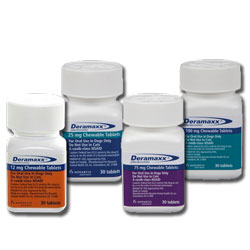Deramaxx Chewable Tablets
+ Save on each recurring order!
Free Shipping on orders over $75
Low Price-Match Guarantee
- Chewable Tablets
- A coxib-class non-steroidal anti-inflammatory drug
- For use in dogs only
Description
DERAMAXX is a nonsteroidal anti-inflammatory drug (NSAID) that is proven safe and effective in controlling the pain and inflammation of osteoarthritis. DERAMAXX has been prescribed to nearly a million dogs over the past two years. Chewable DERAMAXX tablets control painful inflammation for a full 24 hours.
Key Benefits
- Effectively controls pain and inflammation
- Pain-free dogs may be more active and less likely to become overweight
- Controls the pain of Osteoarthritis associated with walking, climbing, standing, and sitting.
- Makes your pet more comfortable, ensuring more refreshing rest and sleep.
How It Works
Deramaxx is a non-steroidal anti-inflammatory drug (NSAID) that belongs to the COX-2 inhibitor class of medications. Deramaxx is different from other NSAIDs because at recommended doses it blocks the COX-2 enzyme, not the COX-1 enzyme. While the COX-1 enzyme is necessary for many normal body functions, COX-2 enzymes trigger inflammation and contribute to pain in arthritic joints.
Indications and Usage
Always provide "information for Dog Owners" Sheet with prescription. Carefully consider the potential benefits and risk of Deramaxx and other treatment options before deciding to use Deramaxx Use the lowest effective dose for the shortest duration consistent with individual response.
Osteoarthritis Pain and Inflammation
Deramaxx Chewable Tablets are indicated for the control of pain and inflammation associated with osteoarthritis in dogs.
Dosage and Administration
Osteoarthritis Pain and Inflammation: 0.45-0.91 mg/lb/day (1 to 2 mg/kg/day) as a single daily dose, as needed.
Dogs needing in a dose of less than 12.5 mg can only be accurately dosed through use of the 12 mg tablet, which can be broken in half to provide 6 mg. Do not attempt to accurately dose smaller dogs through the use of breaking larger tablets. Inaccurate dosing may result in adverse drug events (see Adverse Reactions, Animal Safety, and Post-Approval Experience).
Postoperative Orthopedic Pain and Inflammation
Deramaxx Chewable Tablets are indicated for the control of postoperative pain and inflammation associated with orthopedic surgery in dogs.
Dosage and Administration
Postoperative Orthopedic Pain and Inflammation: 1.4-1.8 mg/lb/day (3 to 4 mg/kg/day) as a single daily dose, as needed, not exceed 7 days of administration.
Dogs needing a dose of less than 12.5 mg can only be accurately dose through use of the 12 mg tablet, which can be broken in half to provide 6 mg. Do not attempt to accurately dose smaller dogs through the use of breaking larger tablets. Inaccurate dosing may result in adverse drug events (see Adverse Reactions, Animal Safety and Post-Approval Experience).
Postoperative Dental Pain and Inflammation
Deramaxx Chewable Tablets are indicated for the control of postoperative pain and inflammation associated with dental surgery in dogs.
Dosage and Administration
Postoperative Dental Pain and Inflammation: 0.45-0.91 mg/lb/day (1 to 2 mg mg/kg/day) as a single daily dose, for 3 days. The first dose should be given approximately 1 hour prior to dental surgery and subsequent doses should be given daily for up to two additional treatments.
Dogs needing a dose of less than 12.5 mg can only be accurately dosed through use of the 12 mg tablet, which can be broken in half to provide 6 mg. Do not attempt to accurately dose smaller dogs through the use of breaking larger tablets. Inaccurate dosing may result in adverse drug events (see Adverse Reactions, Animal Safety, and Post-Approval Experience).
Since Deramaxx tablet bioavailability is greatest when taken with food, postprandial administration is preferable. However, Deramaxx tablets have been shown to be effective under both fed and fasted conditions; therefore, they may be administered in the fasted state if necessary. For postoperative orthopedic and dental pain, administer Deramaxx tablets prior to the procedure. Tablets are scored and dosage should be calculated in half-tablet increments. In clinical practice it is recommended to adjust the individual patient dose while continuing to monitor the dog's status until a minimum effective dose has been reached.
Dogs at risk for osteoarthritis
- Are over the age of five
- Are inactive or overweight
- Are large or giant breed dogs
- Have suffered joint injuries
- Are predisposed to developmental orthopedic disorders such as hip or elbow dysplasia
Signs of pain from Canine Osteoarthritis
- Reluctance to climb stairs
- Stiffness after strenuous exercise or after the rest period following exercise
- Limping
- Difficulty rising, sitting or squatting to defecate or urinate
- Changes in behavior
- Loss of appetite
Contraindications
Dogs with known hypersensitivity to deracoxib should not receive Deramaxx.
Warnings
Not for use in humans. Keep this and all medications out of reach of children. Consult a physician in case of accidental ingestion by humans. For use in dogs only. Do not use in cats.
Dogs needing a dose of less than 12.5 mg can only be accurately dosed through use of the 12 mg tablet, which can be broken in half to provide 6 mg. Do not attempt to accurately dose smaller dogs through the use of breaking larger tablets. Inaccurate dosing may result in adverse drug events (see Adverse Reactions, Animal Safety, and Post-Approval Experience).
All dogs should undergo a thorough history and physical examination before the initiation of NSAID therapy. Appropriate laboratory tests to establish hematological and serum biochemical baseline data prior to, and periodically during, administration of any NSAID is recommended. Owners should be advised to observe for signs of potential drug toxicity (see Adverse Reactions, Animal Safety and Post-Approval Experience) and be given an "Information for Dog Owners" sheet.
Precautions
Dogs needing a dose of less than 12.5 mg can only be accurately dose through use of the 12 mg tablet, which can be broken in half to provide 6 mg. Do not attempt to accurately dose smaller dogs through the use of breaking larger tablets. Inaccurate dosing may result in adverse drug events (see Adverse Reactions, Animal Safety, and Post-Approval Experience).
Since NSAIDs possess the potential to produce gastrointestinal ulceration and/or perforation, concomitant use of deramaxx tablets with other anti-inflammatory drugs, such as NSAIDs or corticosteroids, should be avoided, As a class, NSAIDs may be associated with gastrointestinal, renal and hepatic toxicity. The following collective group of clinical signs has been reported with some serious gastrointestinal events, in decreasing order of reported frequency: anorexia, tachycardia, tachypnea, pyrexia, ascites, pale mucous membranes, dyspnea. In some cases, circulatory shock, collapse and cardiac arrest have also been reported. Sensitivity to drug-associated adverse events varies with the individual patient.
Dogs that have experienced adverse reactions from one NSAID may experience adverse reactions from another NSAID. Patients at greatest risk for adverse events are those that are dehydrated, on concomitant diuretic therapy, or those with existing renal, cardiovascualr, and or hepatic dysfunction. Plasma levels of deracoxib may increase in a greater than dose-proportional fashion above 8 mg/kg/day. Deramaxx tablets have been safely used during field studies in conjunction with other common medications, including heartworm preventatives, anthelmintics, anesthetics, pre-anesthetic medications, and antibiotics.
If additional pain medication is needed after a daily dose of Deramaxx tablets, a non-NSAID/non-corticosteroid class of analgesic may be necessary. It is known whether dogs with a history of hypersensitivity to sulfonamide drugs will exhibit hypersensitivity to Deramaxx tablets. The safe use of Deramaxx tablets in dogs younger than 4 months of age, dogs used for breeding, or in pregnant or lactating dogs has not been evaluated.
NSAIDs may inhibit the prostaglandins which maintain normal homeostatic function. Such anti-oristaglandin effects may result in clinically significant disease in patients with underlying or pre-existing disease that has not been previously diagnosed.
Appropriate monitoring procedures should be employed during all surgical procedures. The use of parenteral fluids during surgery should be considered to decrease potential renal complications when using NSAIDs perioperatively. Concurrent administration of potentially nephrotoxic drugs should be carefully approached.
The use of concomitantly protein-bound drugs with Deramaxx tablets has not been studied in dogs. Commonly used protein-bound drugs include cardiac, anticonvulsant and behavioral medications. The influence of concomitant drugs that may inhibit metabolism of Deramaxx tablets has not been evaluated. Drug compatibility should be monitored in patients requiring adjunctive therapy. Consider appropriate washout times when switching from one NSAID to another or when switching from corticosteroid use to NSAID use.
Palatability
Deramaxx tablets were evaluated for palatability in 100 client-owned dogs of variety of breeds and sizes. Dogs received two doses of Deramaxx tablets, one on each of two consecutive days. Deramaxx tablets were accepted by 94% of dogs on the first day of dosing and by 92% of dogs on the second day of dosing.
Effectiveness
Deramaxx tablets were evaluated in masked, placebo-controlled multi-site field studies involving client-owned animals to determine effectiveness.
Information for Dog Owners
Deramaxx like other drugs of its class, is not free from adverse reactions. Owners should be advised of the potential for adverse reactions and be informed of the clinical signs associated with drug intolerance. Adverse reactions may include vomiting, diarrhea, decreased appetite, dark or tarry stools, increase water consumption, increased urination, anemia, yellowing of gums, skin or white of the eye due to jaundice, lethargy, in-coordination, seizure, or behavioral changes. Serious adverse reactions with this drug class can occur without warning and in some cases result in death (see Warnings, Post-Approval Experience and Adverse Reactions). Owners should be advised to discontinue Deramaxx therapy and contact their veterinarian immediately if signs of intolerance are observed.
The vast majority of patients with drug related adverse reactions have recovered when the signs are recognized, the drug is withdrawn, and veterinary care, if appropriate, is initiated. Owners should be advised of the importance pr periodic follow up for all dogs during administration of any NSAID.
Storage
Deramaxx tablets should be stored at room temperature between 59° and 86°F (15-30°C).
Keep this and all medications out of reach of children.






